If you’re a keyboard player, you might have considered upgrading your keyboard to a digital piano. There are loads of reasons why a piano could benefit you and this guide is here to explain all!
What are the differences and why do they matter?
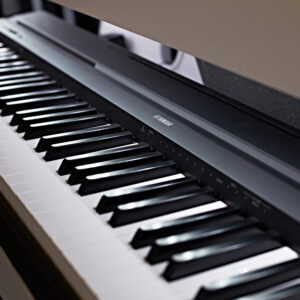 First of all, let’s talk about the differences.
First of all, let’s talk about the differences.
The most notable difference between keyboards and digital pianos is that keyboards are far more portable. Stage pianos are a bit of an exception to this as they’re supposed to be portable, although they’re still often larger and heavier.
There are several reasons for pianos being less portable.
Firstly, they’re designed to be more like furniture pieces that stay put in your room. They’ll also almost always have all 88 keys, whereas keyboards can have fewer which reduces the size and weight.
Another major reason for pianos being heavier is that they have more advanced key action. This is also a big difference between the two instruments and a reason why you may want to upgrade.
Most keyboards have just velocity-sensitive, and perhaps semi-weighted (or organ-style), keys, meaning they can detect how fast you press the keys down. These will feel fairly light under your fingers and not at all like the keys of an acoustic piano.
This isn’t necessarily a bad thing. If you play synth keys in a band or for making music then a velocity-sensitive keyboard is often preferable. Synthesizers don’t respond to touch like a piano does.
On the other hand, digital piano makers spend a lot of time perfecting their key action so that it replicates an acoustic piano. This often involves intricate weights and mechanisms which add a lot of weight to the piano, making it less portable.
Pianos also differ from keyboards in their sounds. Usually, keyboards boast a lot of different instrument tones but these sounds tend not to be particularly detailed. Digital pianos often have less variety, but the piano sounds are more nuanced and accurately simulated.
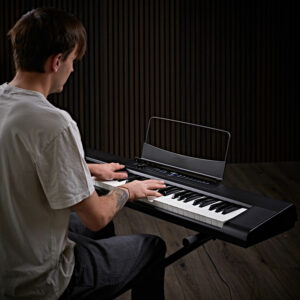 Some modern keyboards do feature more detailed piano sounds as technology advances and companies are able to add fancier sounds into their instruments.
Some modern keyboards do feature more detailed piano sounds as technology advances and companies are able to add fancier sounds into their instruments.
These are often a key selling point and, often, tones will be sampled from real grand pianos for extra realism. In fact, some of the most expensive workstations and arrangers often have high-quality piano sounds.
Casio’s AiX chip, for example, is seen in many of their keyboards, and the sounds are a step up from the piano samples you’d normally find.
The final major difference is the level of polyphony (the number of notes that can sound at the same time). This can range from 64 notes to limitless.
You might wonder why you’d need any more than 10 notes. After all, we only have 10 fingers! Pianos have high amounts of polyphony so that when you hold down the pedal for sustain, you can layer many notes on top of each other.
The higher the polyphony, the more complex layers of notes.
Different types of pianos
I’ve mentioned how some pianos are more portable than others and that many are designed to be furniture pieces. In this section, I’ll explain the differences between the different types of pianos and give some examples.
Stage pianos
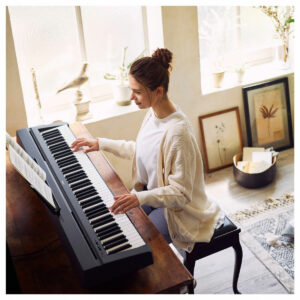 Stage pianos are the most similar to keyboards. They’re designed to be as portable as possible (although they’re often still pretty large and heavy) while having fancier key action and better sounds.
Stage pianos are the most similar to keyboards. They’re designed to be as portable as possible (although they’re often still pretty large and heavy) while having fancier key action and better sounds.
Some brands sell wooden stands for your instrument, so you can enjoy the benefits of portability while also having an attractive piece of furniture in your home.
Stage pianos can cater to different players. Pianos like the Casio CDP-S110 or Yamaha P145 are both affordable and portable, making them ideal for gigging.
The Kawai ES120 is a mid-range piano, it’s a little heavier but has a carefully engineered hammer action keybed. Additionally, the sounds are sampled from Kawai’s grand pianos.
One particular top-range stage piano is the Casio PX-S5000. The S stands for slim and Casio’s intention with these instruments is to make them portable, stylish, and well-designed.
Like the Kawai, it has advanced key action. But this one has three sensors per key, rather than two. The third sensor identifies when the key is being released even if it hasn’t risen all the way back to its normal position. This makes repeated presses of one key feel and sound more realistic.
You can check out more of our picks of stage pianos here!
Shop now | Stage pianos
Digital upright pianos
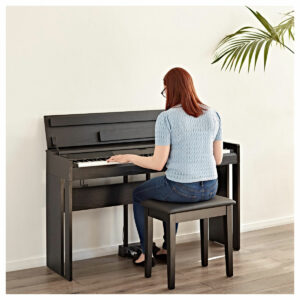 Digital uprights are probably what you associate most with the term “digital piano”.
Digital uprights are probably what you associate most with the term “digital piano”.
These are designed to be similar to an acoustic in performance and size, filling the same space in your home that an acoustic upright would.
They range in price, from affordable starter pianos to top-range instruments that have the most advanced keyboard actions and sounds.
Many digital uprights have a three-pedal unit built in. This gives you the same control over the piano as you would have with an acoustic.
What’s interesting about these pianos is that they can offer different designs for your space. For example, the Casio PX770 and Yamaha YDP 145 both have what might be considered a “classic” digital piano design.
The Kawai KDP120, CN201, and Yamaha CLP 725 are larger and have a more ornate-looking design but still look like their acoustic counterparts.
Our DP-12 piano is a little different, it has a modern, minimal design that sets it apart from other digital pianos.
Shop now | Digital upright pianos
Digital grand pianos
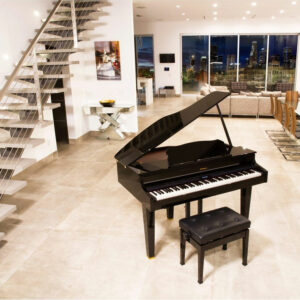 These pianos are among the most expensive and largest digital pianos you can get.
These pianos are among the most expensive and largest digital pianos you can get.
Naturally, the sound and action of these pianos are the best available, but what really sets these ones apart is their design.
Digital grands are designed to look just like a grand piano, with all the benefits of being digital. They take up a lot more space than a digital upright and are meant to be a key focal point of your room.
Their speaker systems are excellent in their own right and many pianos, like the Roland GP607, also allow you to stream music to the piano.
Many digital grands have similar features to acoustic grands. For example, lifting the lid alters the tone much like a real grand piano.
Plus the pedals are weighted, allowing for half damping.
Shop now | Digital grand pianos
Hybrid pianos
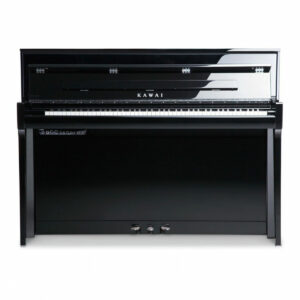 Hybrid pianos are generally regarded as the closest you can get to an acoustic piano without actually having one.
Hybrid pianos are generally regarded as the closest you can get to an acoustic piano without actually having one.
Whilst other pianos have action which uses intricate weights and mechanisms to simulate a genuine piano action, hybrid pianos will usually have the exact key action as that of a real piano.
As a result of this, hybrids feel the closest to a real piano out of any type of digital piano. Of course, these also have the best quality sounds and speaker systems that you can find.
These instruments can be found both in designs that echo an upright piano and ones that look like grand pianos. The Kawai Novus pianos are perfect examples of this.
The Novus NV5S is an upright model and the NV10S is the grand piano version. They’re almost identical in features with obvious exceptions: the NV5S features real upright piano action while the NV10S has grand piano action.
The NV10S also has a speaker system consisting of just standard drivers. On the other hand, the NV5S uses transducers to transmit certain frequencies into a soundboard on the back of the instrument, emulating the way upright pianos produce sound.
We have a guide here if you’d like to learn more about hybrid pianos!
Shop now | Hybrid pianos
What are the benefits of switching to a digital piano?
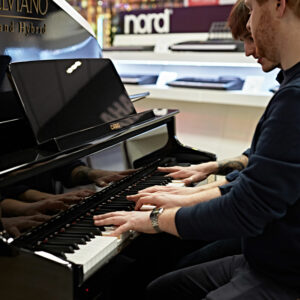 The first and clearest benefit of switching to a piano is that it can greatly help you learn the proper playing technique. A keyboard is great for starting with as you become accustomed to the layout of a keyboard and the physical dexterity needed to play songs.
The first and clearest benefit of switching to a piano is that it can greatly help you learn the proper playing technique. A keyboard is great for starting with as you become accustomed to the layout of a keyboard and the physical dexterity needed to play songs.
However, having more accurate key action will greatly improve the nuances of your technique. The amount of weight you place on the keys and how you hold your arms over the keyboard will be helped with proper feeling keys.
More detailed sounds will also help you hear how well you’re playing. The tiny differences in sound that are produced by varying your playing velocity are fed back to you with sufficiently advanced piano sounds.
There’s also a compelling argument for digital pianos from an aesthetic perspective too. They look great and function as decorative pieces of furniture! And, more practically, having a piano in your home is always nice, you can just sit at it and play whenever you feel.
Plus, if you have guests around then they can also play!
Final thoughts
Let’s quickly sum up some of the points in this article.
You might want to upgrade to a piano if you want more realistic feeling keys and sounds from your instrument or if you want your instrument to look nice in your living space.
We have a wide range of instruments, from stage pianos for portability and compact storage to hybrid grands which look, sound, and feel just like an acoustic. Some are affordably priced instruments, perfect if you’re on a budget, and some are the best digital pianos money can buy.
So why might you not want to upgrade? Well, if you’re more into playing synths or exploring other sounds then a piano may not be for you. The fancy action on pianos, while excellent for playability, might not be ideal if you play other instruments. You also might not be overly worried about detailed piano voicings and prefer more variety in your sound palette.
So, pianos aren’t for you, but you still want to upgrade? Fear not, for you can check out workstation or arranger keyboards. These are top-range keyboards that have been crafted with the same attention to detail as digital pianos. Check out our guide here for information on arrangers vs workstations!
Hopefully, this guide has helped you decide why upgrading to a digital piano from your keyboard can benefit you.


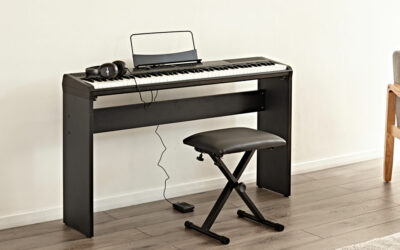
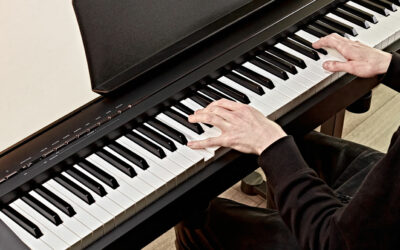

0 Comments